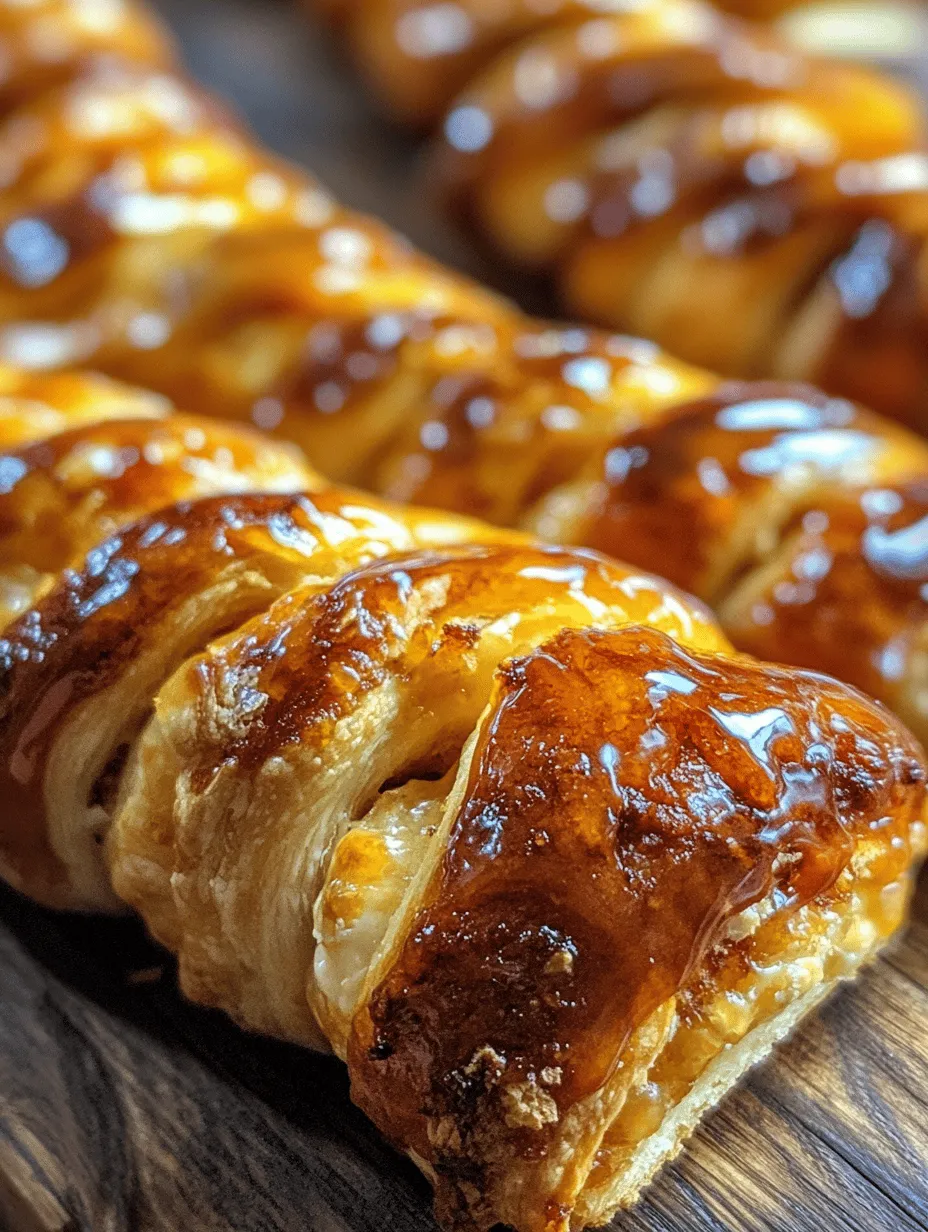Introduction
There’s something undeniably enchanting about pastries that can transport you to a cozy café or a sunlit brunch table. The allure of freshly baked goods, with their aromatic scents and delicate textures, brings joy not only to those indulging in them but also to those creating them. The art of homemade baking allows one to experiment with flavors, textures, and techniques, offering a personal touch that store-bought pastries simply cannot match. Among the myriad of pastry options, the Heavenly Maple Cream Cheese Danish Twists stand out as a delightful treat that combines the richness of cream cheese with the warm, comforting flavor of maple syrup, creating a perfect balance of sweet and savory.
These Danish twists are not only a visual delight with their intricate design but also serve as a testament to the beauty of combining simple ingredients to create something extraordinary. The flaky dough, the creamy filling, and the luscious maple glaze come together to form a pastry that is sure to impress at breakfast, brunch, or even as an afternoon snack. Whether you are an experienced baker or a novice in the kitchen, this recipe will guide you through the process of making these heavenly pastries, ensuring that your baking experience is both enjoyable and rewarding.
Understanding the Ingredients
To embark on this culinary journey, it is essential to understand the main components that make up the Heavenly Maple Cream Cheese Danish Twists. Each ingredient plays a vital role in the overall flavor, texture, and appearance of the final product.
The Dough
The foundation of any pastry lies in its dough, and for this recipe, the dough consists of basic yet crucial ingredients: flour, sugar, yeast, and butter.
– Flour: This is the primary ingredient that provides structure to the Danish. All-purpose flour is typically used, as it strikes the right balance between protein content and gluten development, resulting in a tender yet flaky texture.
– Sugar: Not only does sugar sweeten the dough, but it also aids in browning during baking. The slight caramelization adds depth to the flavor and enhances the overall eating experience.
– Yeast: Instant yeast is preferred in this recipe for its quick-rising properties. Unlike active dry yeast, instant yeast does not require proofing and can be added directly to the dry ingredients. This attribute speeds up the preparation process, making it ideal for those who crave freshly baked pastries without the lengthy wait.
– Butter: Unsalted butter is key to achieving a rich flavor and a tender crumb. The fat in the butter contributes to the flaky layers of the Danish, making each bite melt in your mouth.
The Cream Cheese Filling
Moving on to the star of the show—the cream cheese filling. This component is where the magic happens, as it delivers a creamy, luscious texture and a tangy flavor that perfectly complements the sweetness of the maple syrup.
– Cream Cheese: Softening the cream cheese is crucial for creating a smooth, spreadable filling. When combined with other ingredients, it contributes to the overall richness of the Danish, ensuring that each twist is filled with a delightful creaminess.
– Maple Syrup: As a natural sweetener, pure maple syrup is used in the filling to add depth and a distinct flavor. The unique taste profile of maple syrup elevates the cream cheese, transforming a simple filling into something truly special.
The Maple Glaze
The final touch to these Danish twists is the maple glaze, which enhances the overall taste and provides a glossy finish. The glaze is typically made from powdered sugar and maple syrup, creating a sweet, sticky topping that ties all the flavors together. This glaze not only adds sweetness but also a beautiful sheen that makes the pastries visually appealing.
The Art of Making Danish Dough
Creating the perfect Danish dough is an art that requires attention and care. The dough preparation involves several steps, each contributing to the final result, and understanding these steps is key to achieving the desired texture and flavor.
Step 1: Mixing the Ingredients
To start, combine the dry ingredients—flour, sugar, and instant yeast—in a mixing bowl. It is essential to ensure that the yeast is evenly distributed throughout the flour to promote uniform rising. Next, melt the butter and allow it to cool slightly before adding it to the dry mixture. This step is crucial, as adding hot butter can kill the yeast, preventing your dough from rising properly.
Step 2: Kneading the Dough
Once the butter is added, incorporate warm milk into the mixture to form a soft dough. Kneading the dough is an essential step that develops gluten, giving the Danish its structure. Knead the dough on a floured surface for about 5 to 7 minutes until it becomes smooth and elastic. If you find the dough too sticky, a little extra flour can be added, but be careful not to overdo it, as too much flour can lead to a dense pastry.
Step 3: Allowing the Dough to Rise
After kneading, place the dough in a lightly greased bowl, cover it with a clean kitchen towel, and let it rise in a warm environment until it doubles in size—approximately 1 to 1.5 hours. This fermentation process is vital, as it allows the yeast to produce carbon dioxide, causing the dough to expand and develop flavor.
The Science Behind Fermentation
Understanding the science behind fermentation can enhance your baking experience. During this process, yeast consumes sugars and produces carbon dioxide and alcohol, contributing to the dough’s texture and aroma. The longer the dough rises, the more complex the flavors become, resulting in a richer final product. Patience is indeed a virtue when it comes to baking Danish pastries.
Creating the Cream Cheese Filling
While the dough is rising, you can prepare the delicious cream cheese filling that will transform your Danish twists into a heavenly treat.
Step 1: Soften the Cream Cheese
Begin by taking the cream cheese out of the refrigerator and allowing it to soften at room temperature for about 30 minutes. This step is crucial for achieving a smooth and creamy consistency, which is essential for easy spreading.
Step 2: Mixing the Ingredients
In a medium mixing bowl, combine the softened cream cheese with maple syrup and a splash of vanilla extract. The vanilla extract enhances the flavor profile, adding depth and warmth to the filling. Using a hand mixer or a spatula, mix the ingredients until smooth and well combined. The result should be a creamy filling that is sweet yet balanced, with the maple flavor shining through.
Step 3: Achieving the Right Consistency
It’s important to check the consistency of your cream cheese filling. It should be thick enough to hold its shape when spread but smooth enough to easily spread onto the dough. If it feels too stiff, you can add a touch more maple syrup or a splash of milk to loosen it slightly. Taste the filling and adjust the sweetness if needed, ensuring it complements the pastry without overpowering it.
Assembling the Danish Twists
The final step in this delicious journey is assembling the Danish twists. This stage allows you to visualize the creation process and get creative with the presentation.
Step 1: Rolling Out the Dough
Once the dough has risen, punch it down gently to release excess air and turn it out onto a lightly floured surface. Roll the dough into a large rectangle, approximately 1/4 inch thick. The size of the rectangle will depend on how many Danish twists you wish to create, but a larger rectangle will yield more twists.
Step 2: Spreading the Filling
Spread the prepared cream cheese filling evenly over the rolled-out dough, leaving a small border around the edges. This ensures that the filling does not spill out during the twisting process. Be generous but mindful not to overfill, as this can make twisting difficult.
Step 3: Cutting and Twisting the Dough
Using a sharp knife or a pizza cutter, cut the dough into strips, about 1 inch wide. Take each strip and gently twist it, creating a spiral shape. You can either form the twists into a knot or leave them as spirals, depending on your preference. The visual appeal of the twists adds to the charm of these pastries, making them as beautiful as they are delicious.
Step 4: Spacing on the Baking Sheet
As you place the twisted Danish on a lined baking sheet, ensure there is enough space between each piece. This allows for even cooking and prevents the pastries from sticking together during baking. Allow the twists to rise again for about 30 minutes while preheating the oven. This second rise will create a light and airy texture, enhancing the overall enjoyment of each bite.
By following these steps, you will have laid the groundwork for creating Heavenly Maple Cream Cheese Danish Twists that will delight anyone lucky enough to taste them. The combination of the flaky dough, creamy filling, and sweet glaze is sure to leave a lasting impression, making these pastries a cherished addition to your baking repertoire. Whether you serve them at a gathering or enjoy them with your morning coffee, these Danish twists promise to bring warmth and joy to your kitchen.



